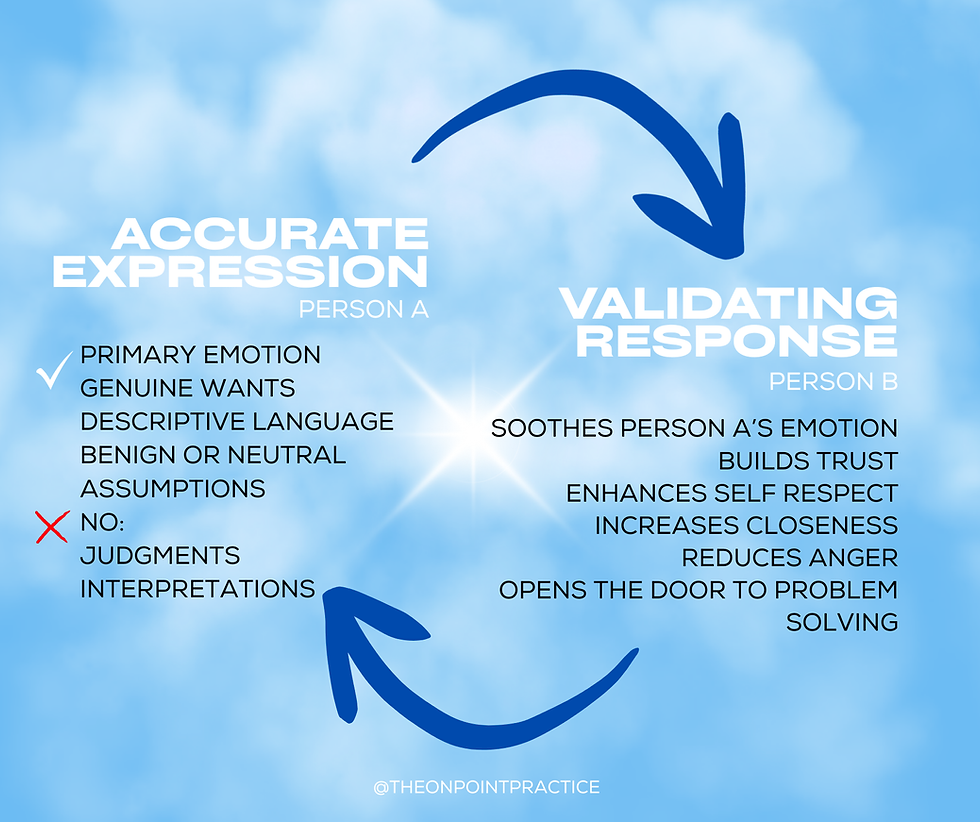The STOP Skill: The Power of the Noble Pause
- Meredith Meyer

- Nov 3
- 4 min read
Yes, just like it sounds, the STOP skill asks us to... STOP. While it may sound so simple it, arguably, is one of the hardest to practice in real time. So let's break it down and show you how to apply it, starting today.
The Anatomy of a Pause
In Dialectical Behavior Therapy (DBT), the STOP skill lives in the Distress Tolerance module — a set of tools designed to help us buy time in the moments we’re most likely to act impulsively or reactively, so we don't make things worse. It’s a skill for when your emotional temperature spikes and your thinking brain goes offline.
STOP is an acronym, but before we get there, it’s worth saying this: the real work of the STOP skill is learning to interrupt momentum.
When emotion takes over, aka when we’re flooded, frustrated, blindsided, or overextended, our bodies surge into automatic action. We send the email. We raise our voice. We make the decision just to make the discomfort end.
And most of the time, those reactions don’t move us closer to what we actually value, it just perpetuates the cycle of urgency -> action.
So, the STOP skill invites a micro-intervention, a sliver of awareness, right in the middle of that emotional storm.
The Four Steps of the STOP skill
S – Stop. Literally freeze. Don’t move a muscle.
This is where mastery begins, in that millisecond of non-action. When you stop, you interrupt the spiral and that, is fantastic alone.
T – Take a step back. Sometimes that means literally, like stepping out of the room or taking a deep breath. More often, it’s mental: pulling the camera lens back. Imagine zooming out on the moment. You’re still in it, but you can see more of the scene, the context, the players, and maybe the possible paths forward.
O – Observe. Observation creates a bridge between emotion mind and wise mind, that middle place where logic and feeling can actually collaborate. So, in this moment, see what’s happening right now... inside you and around you.
What sensations, thoughts, or urges are rising up? What do you notice about the situation itself? Describe it.
P – Proceed mindfully. Before you move back into action, ask yourself: What’s effective in this moment? What action serves my long-term goals, not just my short-term relief?
Sometimes this looks like taking the next best step. Other times it means doing nothing at all, and allowing yourself to pause as long as you need for clarity to return before you act.
Why Stopping Is So Hard
If you’ve ever tried to use the STOP skill mid-conflict or mid-stress, you already know: it’s one thing to understand this skill, and another to practice it when your body’s alarm bells are going off.
That’s because emotional activation narrows the brain’s options. The higher your distress, the lower your cognitive flexibility. You literally can’t see as many solutions when your system is in threat mode.
From a leadership perspective, this is why some of our biggest professional missteps happen in moments of urgency. We act from a sense of “something must be done now,” rather than “what’s needed most.”
The STOP skill interrupts that pattern. It doesn’t make the emotion go away, it gives you a window of awareness where choice becomes possible again. And, how great is that?
Practicing the Pause in Joy
Here’s the paradox: in order to learn the STOP skill, the best time to practice isn’t when you’re falling apart, it’s when things are going well.
Try it right now in this moment. Try it mid-laughter, mid-excitment, mid-bite of something you love. Pause. Notice what’s here. Let yourself feel it fully.
Every time you practice pausing, you’re strengthening your “pause muscle.” And your watching yourself build mastery at taking back control over your automatic actions.
The Leadership Lens
In coaching conversations with founders and executives, I often see the same reflex that shows up in therapy: the urge to solve before seeing.
When we feel discomfort, say with someone that reports to you, or during a tough team meeting, or a missed goal... we rush to act. But action without awareness often amplifies the very problem we’re trying to fix.
The STOP skill is the antidote. It’s not passive. It’s not indecision. It’s a form of intentional leadership presence.
Pausing to assess before you intervene models regulation for your team. It signals steadiness in uncertainty. It creates psychological safety by slowing the emotional contagion that often fuels reactivity.
And on a personal level, it builds internal trust. When you stop and breathe before you respond, you’re showing yourself that you can be with intensity without being consumed by it. And that is why we call it, "The Noble Pause".
Reflection + Practice
Today, try the STOP skill once, even for ten seconds. Notice what shifts when you give yourself the grace of a pause. You may be surprised by how much clarity can fit into a single breath.
Curious to learn more? Check out Distress Tolerance episodes @theskillspodcast.




.png)


Comments